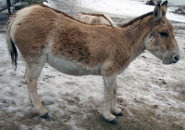 The Kulan (Equus hemionus) is known by many names such as the khulan, the Mongolian wild ass, the wild Asian ass and the onager. But no matter what it is called, never call this close relative of the donkey domesticated. Although there have been many attempts to tame individual kulans, all have been unsuccessful. This species refuses to bow to any master.
The Kulan (Equus hemionus) is known by many names such as the khulan, the Mongolian wild ass, the wild Asian ass and the onager. But no matter what it is called, never call this close relative of the donkey domesticated. Although there have been many attempts to tame individual kulans, all have been unsuccessful. This species refuses to bow to any master.There are six subspecies of kulan, which can all interbreed. The subspecies of kulans are similar to breeds of horses. Genetically, they carry the same amount of chromosomes but differ in appearance. The most numerous is Mongolian wild ass (Equus hemonius hemonius.) A seventh subspecies, the Syrian wild ass (Equus hemonious hemippus) went extinct in the wild in 1927. Kulans can still be found in the deserts and salt flats of northern India, Mongolia, Iran and Turkmenistan.
Physical Description
The kulan more resembles Przewalski’s horse (Equus ferus przewalskii) more than the modern donkey. Their bodies are two-toned, with a light tan or dun head, back and rump and a pale belly, muzzle and inner legs. Many have a dorsal stripe, or a dark stripe of dark brown or black running from the base of the neck to the top of the tail. In the winter, coasts become a darker red than their sleek summer coats.
Behavior and Herd Life
Kulans enjoy socializing with other kulans. They live in pairs or small herds. Stallions help protect their mares and foals, but over half of foals born in the wild die before they become yearlings. Foals can nurse from one to two years, depending on food availability and drought conditions. Kulans become sexually mature when they are two. Stallions from different herd or pair-bonds have been known to come together to attack wolves, their only predator outside of humans.
But the onager’s main defense is its speed, which is just as fast a thoroughbred racehorse. They can reach speeds up to 43 miles per hour (70 kilometers per hour.) But they cannot outrun bullets. Although they are a protected species, Onagers are heavily hunted for their meat and their skins. Farmers may kill kulans so their grazing animals do not have competition for food such as grasses, twigs and bark. Kulans live short lives in comparison to domestic animals. In the wild, they often die by the age of 7, but can live twice as long in captivity. Although kulans do well in zoos and safari parks, they are still wild animals. Their powerful kicks with their hind legs can severely injure or even kill a person.
Keywords: brown , black , stripe , white
The Asian wild ass, asiatic wild ass, kulan is listed as Vulnerable (VU), considered to be facing a high risk of extinction in the wild, on the IUCN Red List of Threatened Species
Some facts about the
Kulan
Adult weight : 230 kg (506 lbs)
Maximum longevity : 26 years
Female maturity :1157 days
Male maturity : 1187 days
Gestation : 339 days
Weaning : 456 days
Litter size : 1
Litters per year : 1
Interval between litters : 458 days

Custom Search